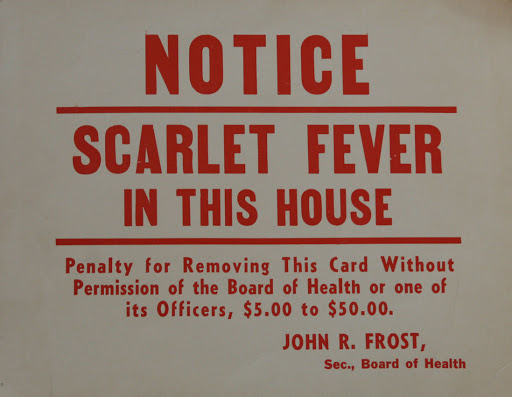“I contracted scarlet fever as a young girl. I remember the red quarantine sign tacked outside our front door stating we were confined to our home and no one was to be admitted. Now I live in California. Before locking down the whole state, Gov. Gavin Newsom asked seniors to “isolate themselves” from others.” So began an article in a recent issue of the Wall Street Journal.
It reminded me that I also had been quarantined, along with my sister and brother, in Andover, Ashtabula County, Ohio, probably in 1946 or 1947.
I don’t remember much about the time we spent in quarantine so I contacted my siblings by email seeking their memories of quarantine. Our consensus is that we didn’t suffer too much from the symptoms of scarlet fever, including red rashes and sore throats. As kids of elementary school age, we probably drove our mother a bit crazy cooped up in the house for probably two weeks. We did recall that there was a red sign next to the front door of our house on South Main Street. We all recall seeing a photo of our house with the sign, but we have not been able to locate it. A Google search turned up this historic image:

A scarlet fever quarantine sign.
In doing some further research online about scarlet fever, I learned that the disease is quite contagious and that it is related to what is now called “strep throat.”
An article on Wikipedia.www states that it most commonly affects children between five and 15 years of age. I and my siblings were in the low end of that range. The article from Wikipedia further states:
“The bacteria are usually spread by people coughing or sneezing. It can also be spread when a person touches an object that has the bacteria on it and then touches their mouth or nose. The characteristic rash is due to the erythrogenic toxin, a substance produced by some types of the bacterium. The diagnosis is typically confirmed by culturing the throat.
“There is no vaccine. Prevention is by frequent handwashing, not sharing personal items, and staying away from other people when sick. The disease is treatable with antibiotics, which prevent most complications. Outcomes with scarlet fever are typically good if treated. Long-term complications as a result of scarlet fever include kidney disease, rheumatic heart disease, and arthritis. It was a leading cause of death in children in the early 20th century.
My brother recalled one other thing about our quarantine. At the time, we were receiving milk deliveries from a dairy in the next town. The delivery man was able to continue delivering the bottles of milk, but he could not pick up the empties until our quarantine was over.
Wikipedia URL — https://en.wikipedia.org/wiki/Scarlet_fever

Leave a Reply